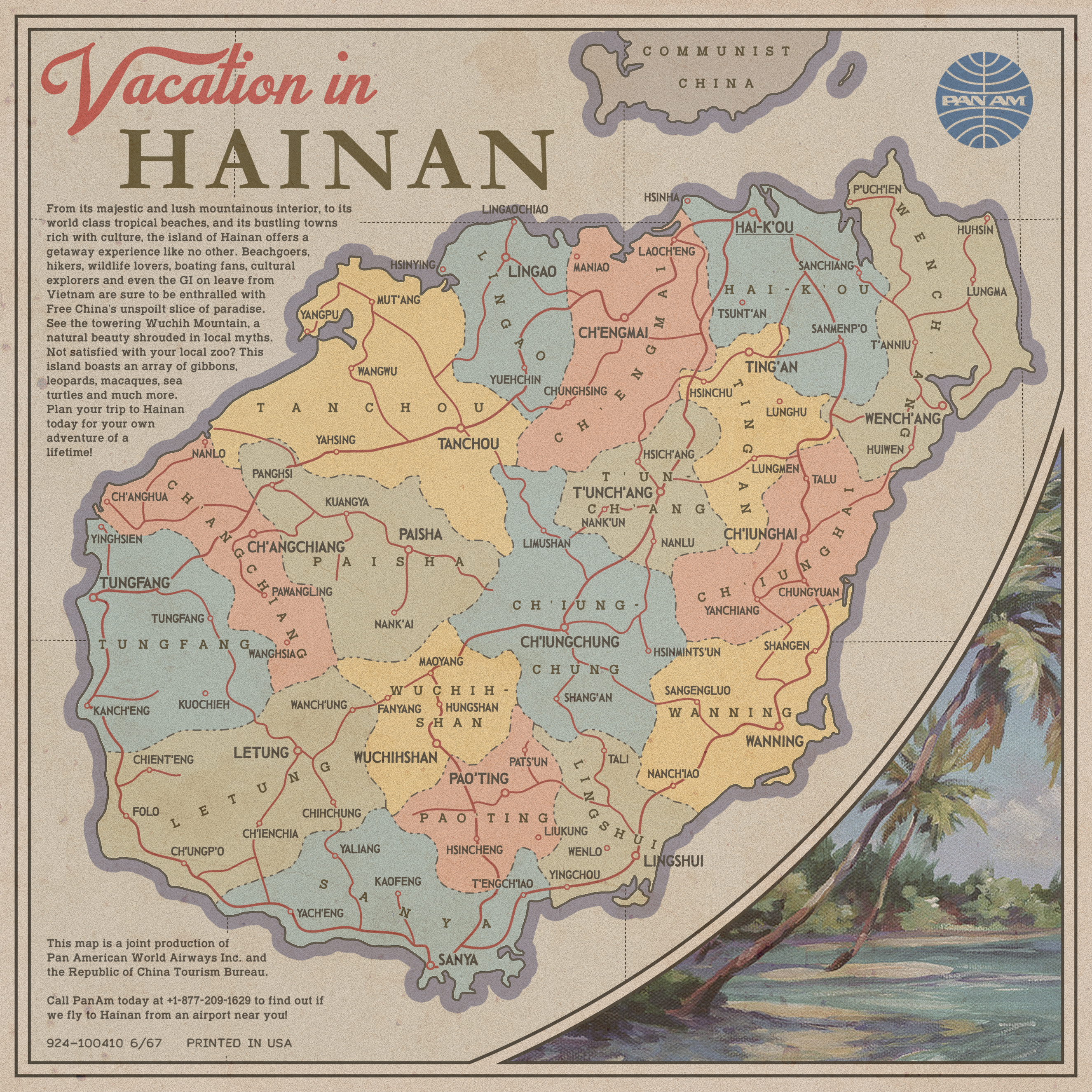HOME | DD
 FDrizel — A Tourist's Map of Hainan - 1967 [RoC Control]
FDrizel — A Tourist's Map of Hainan - 1967 [RoC Control]

#alternatehistory #antique #cartography #china #hainan #historical #history #map #roc #taiwan #tourist #vintage #althistory #republicofchina #chinesecivilwar #old
Published: 2021-02-04 22:24:48 +0000 UTC; Views: 11737; Favourites: 130; Downloads: 23
Redirect to original
Description
In March 1950, a smallpox outbreak in the interior of the Chinese island of Hainan had been wreaking havoc for nearly four months, with thousands of fatalities. The impacts of the epidemic were drastically worsened by the political situation on the island in the context of the Chinese Civil War. While most of the island was under the control of Kuomintang forces, the interior was largely controlled by the communist-aligned Qiongya Column, both involved in an armed struggle for control of the territory.
Under the command of Xue Yue, the KMT were keen to cut off medical aid to the Column in order to obtain a strategic upper hand. The result was catastrophic for interior forces; left without any medical assistance, the smallpox epidemic was a particularly devastating one, even worse than a similarly fatal outbreak in Hainan’s interior in 1918. Of the 15,000 strong Column, over 6,000 died and several thousand more were left incapacitated. Given the high civilian casualties accompanying this, it was a humanitarian disaster. For the Nationalist forces however, it was a favourable disaster. A renewed assault on the interior beginning on the 2nd of March decimated the Column’s front line troops, forcing a panicked retreat, and within just 2 days the force was all but defeated.
This development was perceived by the local KMT as a relief, albeit minor in terms of significance given the small nature of the Qiongya force. The real threat, it was seen, was positioned across the Qiongzhou Strait on the mainland. Unbeknownst to Hainan’s garrison at the time, however, was that the interior’s smallpox outbreak and its consequences had a crucial role in keeping the island secure from communist attack.
An emergency meeting of People’s Liberation Army commanders was convened at 6:00pm on the 5th of March in Xuwen, across the Straits from Hainan. Just an hour before a small fleet of junks were scheduled to sail across the Straits to make a landing designed to probe KMT defences, Deng Hua, the PLA commander of the Fourth Army’s XV Corps, called for the operation to be aborted. The reason for this was that a crucial part of this initial landing’s plan was to link up with forces of the Qiongya Column to ease the mission, enabling a larger force to land later once enough territory was secured. With reports that no such aid from the Column would be available after its defeat just a day earlier, the integrity of the entire operation was jeopardised. As such, Deng Hua called for a week’s postponement to readjust plans for Hainan’s ‘liberation’.
The situation had shifted towards the KMT’s favour, when at first it seemed the demoralised and overstretched Nationalist forces would be hard-pressed to defend the island. The week of delay in the PLA’s plan enabled Xue Yue to move troops previously assigned to eradicating the Qiongya Column northwards so as to bolster coastal defences. For this reason, when the probing landing occurred on the 12th (assigned a greater number of troops given the collapse of the Column), PLA soldiers encountered stern resistance at their two designated landing sites. At Baimajing on Hainan’s western coast, Communist troops encountered particularly heavy resistance, leading to much of the landing force being wiped out and survivors being captured or committing suicide. While the landing on the eastern coast at Chishui was not as disastrous, similarly fortified KMT positions prevented the PLA from making any meaningful inland gains, and the troops were forced to withdraw back across the Strait under cover of darkness as supplies ran low.
The botched operation resulted in Deng Hua offering his resignation from command of the XV Corps, and motivated PLA leaders to begin drafting entirely new invasion plans. Knowing that conditions for invasion would be favourable throughout the entirety of Spring and Summer, the date for a large scale amphibious landing was pushed back to mid-May.
On the 16th of May, after receiving the go-ahead from Moscow, forces of the Democratic People’s Republic of Korea moved south of the 38th parallel, seeking to take control of the entire peninsula. This action had begun the Korean War that would last for years to come, and put a major spanner in the works for Chinese designs on capturing the remaining Nationalist strongholds of Taiwan and Hainan. Just months earlier, President Truman of the United States had assured the international community that America would not intervene to defend either Taiwan or Hainan. This position rapidly shifted with the outbreak of war in Korea however, as fears arose in the US that Communist advances in Korea could be compounded, while the world was distracted, with the capture of Taiwan and Hainan by the People’s Republic of China. As Truman’s policy of containment developed, and the voice of the pro-Taiwan lobby in congress grew louder, the United States deployed their 7th naval fleet to the Taiwan and Qiongzhou Straits in order to safeguard the KMT garrisons on these islands.
Despite vocal Chinese protests at this action, the decision to deploy the US navy had worked in warding off attacks by the PRC on either island, especially given that the PRC itself intervened in Korea in September and was forced to temporarily place its strategic focus elsewhere. The fleet’s deployment was the first in a series of actions that would build a strong relationship between the United States and the Republic of China, only growing stronger as the Cold War developed.
Related content
Comments: 2

👍: 1 ⏩: 0

👍: 1 ⏩: 0























